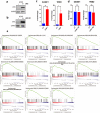Expression profiling of ubiquitin-related genes in LKB1 mutant lung adenocarcinoma
- PMID: 30185829
- PMCID: PMC6125361
- DOI: 10.1038/s41598-018-31592-2
Expression profiling of ubiquitin-related genes in LKB1 mutant lung adenocarcinoma
Abstract
Liver kinase B1 (LKB1) is a tumor suppressor, and there is a very high proportion of LKB1 mutation in lung adenocarcinoma. The function of LKB1 is closely related to that of ubiquitin related genes. Our objective is to analyze the changes in ubiquitin-related genes in LKB1 mutant lung adenocarcinoma. We searched The Cancer Genome Atlas (TCGA) and obtained gene expression profiles from 230 lung adenocarcinoma patients, which were then analyzed using R software. Kaplan-Meier curves and Cox proportional hazards regression were applied to estimate survival. Real-time reverse transcription PCR was used to verify gene expression. Gene function was explored by gene set enrichment analysis. There were significantly expressed differences in the ubiquitin-related gene SH3RF1 between the LKB1 mutant and wild-type lung adenocarcinoma patients (p = 9.78013E-05). Patients with LKB1 mutation and high expression of SH3RF1 had a better prognosis than the low expression group (HR 0.356, 95% CI 0.136-0.929, p = 0.035). SH3RF1 can influence cell cycle, apoptosis, DNA replication and the p53 signaling pathway. SH3RF1 might have great clinical value act as a diagnostic biomarker and indicator to evaluate the prognosis of LKB1 mutant lung adenocarcinoma patients. This gene also can become a new treatment target for LKB1 mutant lung adenocarcinoma patients.
Conflict of interest statement
The authors declare no competing interests.
Figures




Similar articles
-
Loss of FGL1 induces epithelial‑mesenchymal transition and angiogenesis in LKB1 mutant lung adenocarcinoma.Int J Oncol. 2019 Sep;55(3):697-707. doi: 10.3892/ijo.2019.4838. Epub 2019 Jul 15. Int J Oncol. 2019. PMID: 31322182
-
LKB1 loss by alteration of the NKX2-1/p53 pathway promotes tumor malignancy and predicts poor survival and relapse in lung adenocarcinomas.Oncogene. 2014 Jul 17;33(29):3851-60. doi: 10.1038/onc.2013.353. Epub 2013 Sep 2. Oncogene. 2014. PMID: 23995788
-
Immunohistochemical Loss of LKB1 Is a Biomarker for More Aggressive Biology in KRAS-Mutant Lung Adenocarcinoma.Clin Cancer Res. 2015 Jun 15;21(12):2851-60. doi: 10.1158/1078-0432.CCR-14-3112. Epub 2015 Mar 3. Clin Cancer Res. 2015. PMID: 25737507
-
The molecular mechanisms that underlie the tumor suppressor function of LKB1.Acta Biochim Biophys Sin (Shanghai). 2009 Feb;41(2):97-107. doi: 10.1093/abbs/gmn011. Acta Biochim Biophys Sin (Shanghai). 2009. PMID: 19204826 Review.
-
LKB1 and lung cancer: more than the usual suspects.Cancer Res. 2008 May 15;68(10):3562-5. doi: 10.1158/0008-5472.CAN-07-6620. Cancer Res. 2008. PMID: 18483235 Review.
Cited by
-
Genetic variation at a splicing branch point in intron 7 of STK11: a rare variant decreasing its expression in a Chinese family with Peutz-Jeghers syndrome.World J Surg Oncol. 2024 Jul 30;22(1):202. doi: 10.1186/s12957-024-03475-6. World J Surg Oncol. 2024. PMID: 39080663 Free PMC article.
-
The therapeutic significance of the novel photodynamic material TPE-IQ-2O in tumors.Aging (Albany NY). 2020 Dec 19;13(1):1383-1409. doi: 10.18632/aging.202355. Epub 2020 Dec 19. Aging (Albany NY). 2020. PMID: 33472175 Free PMC article.
-
Establishment and validation of a ubiquitination-related gene signature associated with prognosis in pancreatic duct adenocarcinoma.Front Immunol. 2023 Jun 9;14:1171811. doi: 10.3389/fimmu.2023.1171811. eCollection 2023. Front Immunol. 2023. PMID: 37359528 Free PMC article.
-
A novel model based on ubiquitination-related gene to predict prognosis and immunotherapy response in hepatocellular carcinoma.Heliyon. 2024 Apr 9;10(8):e29387. doi: 10.1016/j.heliyon.2024.e29387. eCollection 2024 Apr 30. Heliyon. 2024. PMID: 38628739 Free PMC article.
-
6-Shogaol Inhibits Oxidative Stress-Induced Rat Vascular Smooth Muscle Cell Apoptosis by Regulating OXR1-p53 Axis.Front Mol Biosci. 2022 Jan 31;9:808162. doi: 10.3389/fmolb.2022.808162. eCollection 2022. Front Mol Biosci. 2022. PMID: 35174215 Free PMC article.
References
-
- Siegel RL, Miller KD, Jemal A. Cancer Statistics, 2017. CA: a cancer journal for clinicians. 2017;67:7–30. - PubMed
Publication types
MeSH terms
Substances
Grants and funding
LinkOut - more resources
Full Text Sources
Other Literature Sources
Medical
Research Materials
Miscellaneous

